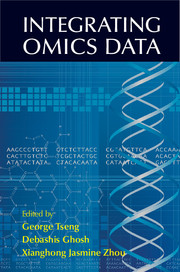Book contents
- Frontmatter
- Contents
- Contributors
- Introduction
- Part A Horizontal Meta-Analysis
- 1 Meta-Analysis of Genome-Wide Association Studies: A Practical Guide
- 2 MetaOmics: Transcriptomic Meta-Analysis Methods for Biomarker Detection, Pathway Analysis and Other Exploratory Purposes
- 3 Integrative Analysis of Many Biological Networks to Study Gene Regulation
- 4 Network Integration of Genetically Regulated Gene Expression to Study Complex Diseases
- 5 Integrative Analysis of Multiple ChIP-X Data Sets Using Correlation Motifs
- Part B Vertical Integrative Analysis (General Methods)
- Part C Vertical Integrative Analysis (Methods Specialized to Particular Data Types)
- Index
- Color plates
3 - Integrative Analysis of Many Biological Networks to Study Gene Regulation
from Part A - Horizontal Meta-Analysis
Published online by Cambridge University Press: 05 September 2015
- Frontmatter
- Contents
- Contributors
- Introduction
- Part A Horizontal Meta-Analysis
- 1 Meta-Analysis of Genome-Wide Association Studies: A Practical Guide
- 2 MetaOmics: Transcriptomic Meta-Analysis Methods for Biomarker Detection, Pathway Analysis and Other Exploratory Purposes
- 3 Integrative Analysis of Many Biological Networks to Study Gene Regulation
- 4 Network Integration of Genetically Regulated Gene Expression to Study Complex Diseases
- 5 Integrative Analysis of Multiple ChIP-X Data Sets Using Correlation Motifs
- Part B Vertical Integrative Analysis (General Methods)
- Part C Vertical Integrative Analysis (Methods Specialized to Particular Data Types)
- Index
- Color plates
Summary
Abstract
Gene expression is a complex process regulated and coordinated through the interactions of cellular components. In recent years, there has been an increasing accumulation of high-throughput biological network data characterizing these interactions at multiple levels and under different conditions and perturbations. Integrative analysis of many such networks is an important means of understanding the complexity of gene regulation. Therefore, there is an urgent need for powerful integrative methods capable of analyzing many biological networks simultaneously. In this chapter, we review three state-of-the-art studies that develop computational methods for identifying three types of patterns in multiple networks: transciptional modules, splicing modules, and coupled transcription-splicing modules. The atlas of these modules facilitates understanding of gene regulation processes, through reconstructing transcriptional regulatory networks, splicing regulatory networks, and exploring how transcription and splicing simultaneously take place.
Introduction
Gene regulation is an intricate system involving precise interactions between tens of thousands of cellular components, and sophisticated systems coordinating diverse activities across multiple layers. Biological networks are undoubtedly the most expressive data source for describing this interconnectivity. Understanding the complexities of these networks has become a mainstay of systems biology, and is rapidly growing into a new subfield known as network biology. High-throughput genomic technologies are providing unprecedented opportunities to systematically characterize diverse types of biological networks, including protein-protein interactions, metabolic reactions, signaling and transcription-regulatory networks, and coexpression relationships. These networks characterize the variety of the interactions and activities of cellular components and have great potential to reveal underlying gene regulation mechanisms.
Extensive research indicates that gene regulation is governed by multiple, complex, and extensively coupled networks, which can be generated under different conditions and perturbations. Therefore, a single network is insufficient to discover network patterns with multiple facets, subtle signals, and dynamic features, which are often embedded in multiple networks with diverse conditions. A paradigmatic example is the high-order cooperativity analysis of gene regulation presented in this chapter. In addition, single networks often include many false positive signals (edges) incurred by experimental biases and errors, whereas integrative analysis of many networks can produce more reliable results by focusing only on those patterns that frequently occur across multiple networks. Therefore, there is an urgent need for novel computational methods supporting the integrative analysis of many biological networks.
- Type
- Chapter
- Information
- Integrating Omics Data , pp. 68 - 87Publisher: Cambridge University PressPrint publication year: 2015

